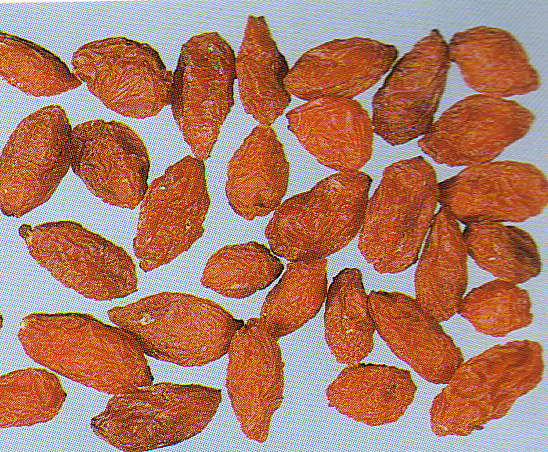
| What is Flavor and Fortune? |
| How do I subscribe? |
| How do I get past issues? |
| How do I advertise? |
| How do I contact the editor? |
Read 12996856 times
Connect me to:
| Home |
| Articles |
| Book reviews |
| Letters to the Editor |
| Newmans News and Notes |
| Recipes |
| Restaurant reviews |
| Article Index (all years, slow) |
| List of Article Years |
| Article Index (2025) |
| Article Index (last 2 years) |
| Things others say |
| Related Links |
| Log In... |
| Authors |
| Categories & Topics |
Wolfberry
| by Jacqueline M. Newman |
Fruits, Desserts, and Other Sweet Foods
Summer Volume: 2005 Issue: 12(2) page(s): 35, 36, AND 38

 The fruits of the matrimony vine are its berries. They are known as boxthorn, boxthorn berries, Chinese boxthorn, medlar, and wolfberries. They are but one part of the plant used by the Chinese. They and other parts of this popular item are used as both food and medicine. In the Solanaceae family, the plant is specifically known as Lycium chinense or Lycium barbarum. It was mentioned, as are many, in the Shen Nong Ben Cao which is also known as the Chinese Materia Medica.
The fruits of the matrimony vine are its berries. They are known as boxthorn, boxthorn berries, Chinese boxthorn, medlar, and wolfberries. They are but one part of the plant used by the Chinese. They and other parts of this popular item are used as both food and medicine. In the Solanaceae family, the plant is specifically known as Lycium chinense or Lycium barbarum. It was mentioned, as are many, in the Shen Nong Ben Cao which is also known as the Chinese Materia Medica.
Every part of Lyciium chinense has value. The berries are the most popular now but early medicinal use was limited to the leaves, which are not known as wolfberry nor as boxthorn, but called 'matrimony vine.' Leaves and berries are used as food, they and root and bark are helpful for many ailments.
The berries, the leaves too, are popular for culinary purposes; and the leaves are adored as fresh vegetables, when in season. Both are used in soups and stews, cooked with pork, chicken, and other meats, and used in many other ways including that the berries are used as a tea. This multi-functional medicinal food has many Chinese names. Most commonly, the plant is called gou qi. The bark is known as di gu pi, the fruit as guo qi pi. In general, it is also referred to as: niu ji li, quo ya zi, quo qi tou, quo qi miao, and by several other names.
The wolfberry plant bears red berries. It is a thorny deciduous shrub with flowers, depending upon the species, varying in color from orange to red; but they can also be pink or purple, when immature. The previously mentioned Chinese names can refer to different parts of the plant; but that can change from one region to another. They can also change from one variety of the plant to another. People in other parts of the world know the general genus of this plant. Native Americans call it 'desert thorn.' In Mexico, and among Spanish speakers it is known as 'frutillos.'
This shrub can grow to heights of twelve feet, but often is pruned to man-reaching heights making picking leaves and berries easier; often the soil is so poor it never reaches those heights. The plant is readily available, found in the wild, and planted around Chinese homes. The most common variety in China is considered extremely hardy so it is found all over the country though it is believed to have origins in Northern China.
Because it is easily propagated and popular, some ethnographers use it as a horticultural marker to follow the migration of Chinese as they moved to all parts of the world. The Chinese Historical Society of the Pacific Northwest reports they follow growth patterns of this shrub and see them related to where the Chinese have gone and taken up residency.
Wolfberries are popular and grow wild and in cultivated gardens, most of the latter are kept pruned to three to five feet. They are common from the Ningxia Autonomous Province to Langzhou in the Gansu province. In these places, most are watered by China’s longest river, the Yellow River. Most recently, large plantations, usually called 'gardens,' have been developed in the Qinghai province; they are growing there most successfully. This shrub seems to do well on marginal soil, so few places are now without hedges or loose plants of Lycium chinense.
The plant is generally considered bittersweet. People are attracted to its berries as they are sweet with some overtones of sour. The bark is said to be a bitter component. The Materia Medica mentions that the leaves invigorate qi, enrich the blood, increase virility, remove excess heat, and cure rheumatism. With that pedigree, its popularity is ensured.
In the Tang Dynasty (618 - 907 CE), use of the plant as a tonic increased after a poet said “it tastes like sweet dew and promotes longevity with a spoon’s chew.” In the Song Dynasty (960 - 1279 CE), rulers told commoners that this warming and strengthening plant with its neutral nature and sweet flavor was to be adored. Quickly, they knew to make it a tribute food and they sent it to the Imperial Court frequently.
Traditional Chinese medicine doctors recommend this the wolfberry for a host of ailments. They use it as both tonic and tranquilizer. They do not recommend the bark for fever due to cold but say the berries are to be taken for that condition. They advise avoiding the berries if suffering from diarrhea due to deficiencies of the spleen, and otherwise to eat them but not to eat them in excess.
Nowadays, wolfberries are given to diabetics. They tell them to cook them, add water to their juice, and to drink this as a tea. Other parts of the plant are recommended for toothache, migraine, conjunctivitis, and for hemorrhoids. However, when taking any part for these reasons, the admonition is not to consume dairy products.
In ancient China and today, wolfberries are used to improve vision, enhance kidney function, and relieve soreness in the loins. The bark, made into a decoction, is to aid lung problems in children. All ages need to know that newly sprouted leaves purify the blood.
Wolfberries can be purchased in herbal stores and in Chinese supermarkets. The bark is only available in herbal emporia, the leaves only in supermarkets. Wolfberry syrup can be found in both and we recommend you look for it in cans, cardboard boxes, and in reinforced multi-layer plastic bags and pouches. The wolfberry makes a refreshing drink when diluted and chilled, and people of all ages seem to delight in drinking it. It is so common and so popular in China, that roadside stands sell both berries and beverages made from them.
We use the berries, also known as Frustus lycii, in stewed Chinese yam and chicken dishes, in eel dishes with and without yams, in long-cooked lily bulb main courses, when mixed with spare ribs, in chicken soups, fish stews, etc. Try these and the many other recipes found in Chinese cookbooks. Enjoy eating these high vitamin C fruits, they are health giving. Serving them offers color to colorless or foods because they do not fade much in the cooking. And everyone should know an old saying about them, It warns married men not to take them when far away from home. The implication, they have considerable ability to arouse sexual desires.
| Chicken, Yam, and Wolfberries |
|---|
1 two to two-and-a-half pound chicken, cut into four pieces 1/4 pound lean pork, minced coarsely 4 pieces dried Chinese yam, each broken in half 2 pieces tangerine peel, soaked for twenty minutes, then minced 3 Tablespoons wolfberries 4 slices ginger root, minced 1 Tablespoon Chinese rice wine 1 Tablespoon thin soy sauce 1/2 teaspoon salt 1/2 teaspoon sesame oil Preparation: 1. Put chicken pieces and pork into eight cups of water, bring to the boil, skim off any scum, then reduce the heat to a simmer. 2. Add all remaining ingredients and simmer five minutes. 3. Prepare a steamer, transfer the liquid and the ingredients to a large serving bowl and steam for two hours. 4. Remove chicken pieces, discard sin and bones, and cut chicken into one-inch pieces, return them to the bowl, and serve. |
| Spare Rib Soup with Wolfberries |
|---|
2 pounds spare ribs, have the butcher cut them into one-inch pieces 1 Tablespoon oil 3 Tablespoons wolfberries 10 red Chinese dates, simmered for five minutes, pits removed 3 slices of fresh ginger Preparation: 1. Bring two quarts of water to the boil, and put spare ribs into it and simmer for two minutes, remove spare ribs and discard the water. 2. Heat oil and fry the spare ribs until brown, be careful as they splatter when first put into the oil; remove and drain well. 3. Bring two quarts of water or chicken stock to just below boiling, as spare ribs and all other ingredients, then reduce heat and simmer for ninety minutes. Remove meat from the bones if desired, then serve. |
| Stewed Seabass with Wolfberries |
|---|
1 two-pound sea bass 3 slices fresh ginger, slivered 3 Tablespoons wolfberries 5 sprigs fresh coriander, minced coarsely 1/2 teaspoon salt 1 Tablespoon Chinese rice wine 4 teaspoons cornstarch or water chestnut flour Preparation: 1. Scale fish, remove viscera, rinse, and dry. Make two cuts on each side through the skin, but not into the flesh. 2. Rub ginger, wolfberries, coriander, and salt into the cavity of the fish. 3. Bring two cups water to the boil in a long narrow fish pot. Simmer the fish, covered, for twenty minutes, remove carefully to a platter, reserving liquid in the fish pot. 4. Mix cornstarch with one tablespoon of cold water, add to the remaining liquid and cook until thickened. Then pour over the fish and serve. |
| Wolfberries and Matrimony Vine Soup |
|---|
8 cups chicken broth 6 Tablespoons wolfberries 3 cups matrimony vine greens, removed from their stems 1/2 teaspoon salt Preparation: 1. Bring chicken broth to a simmer, add wolfberries, and simmer for ten minutes. 2. Add greens, discarding the stems, and the salt and bring liquid to the boil. Cook two minutes, remove from heat, and serve. |

Copyright © 1994-2025 by ISACC, all rights reserved
Address
3 Jefferson Ferry Drive
S. Setauket NY 11720